20 Reasons to Travel to Antarctica Now (Before It Changes)
Original content owned & copyrighted by Green Global Travel. There are more opportunities to travel to Antarctica today than there ever have been before, but most people still relegate this trip to the “someday” category. A bucket list destination for many nature lovers, Antarctica is a remote and isolated continent full of inspiring natural wonder. It’s widely regarded as one of the most strikingly Keep Reading The post 20 Reasons to Travel to Antarctica Now (Before It Changes) appeared first on Green Global Travel.
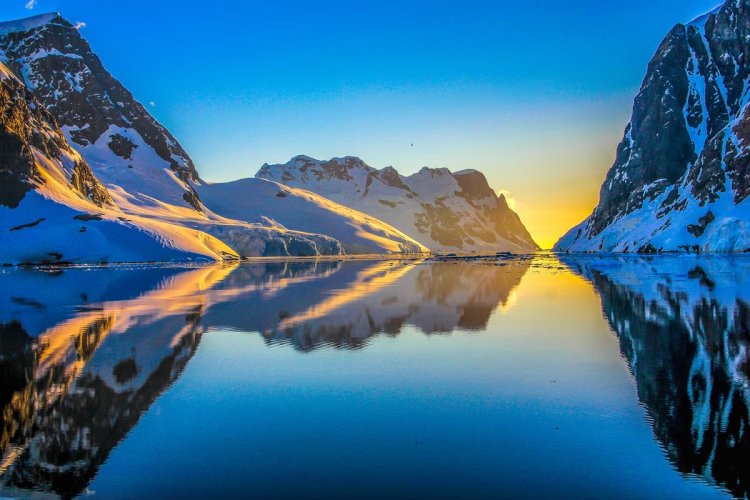
Original content owned & copyrighted by Green Global Travel.
There are more opportunities to travel to Antarctica today than there ever have been before, but most people still relegate this trip to the “someday” category.
A bucket list destination for many nature lovers, Antarctica is a remote and isolated continent full of inspiring natural wonder.
It’s widely regarded as one of the most strikingly beautiful places on the planet, with pristine landscapes and a wealth of wildlife thriving in one of the last corners of the Earth that development hasn’t truly touched.
But with a rapidly warming climate changing the ice-covered landscape and limited space to satisfy an ever-increasing tourism demand, those who wait might find themselves too late to see the continent at its best.
The following are 20 great reasons to travel to Antarctica now, before your personal “someday” never comes.
READ MORE: What Is Ecotourism? (The History & Principles of Responsible Travel)
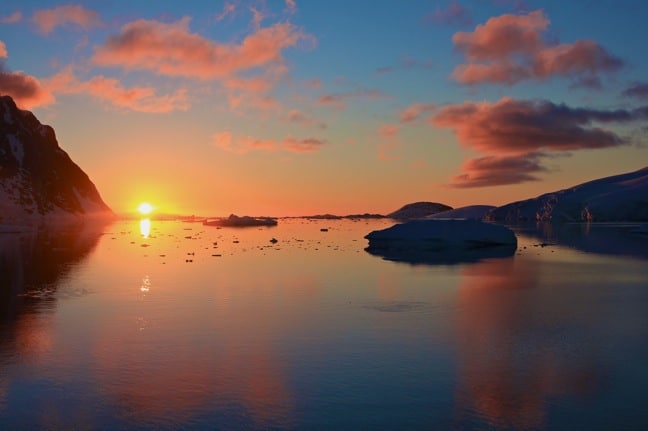 Midnight Sunset in Antarctica
Midnight Sunset in Antarctica
Reasons to Travel to Antarctica Guide
- The Antarctic Islands
- Antarctic Wildlife
- Penguins
- Seals
- Whales
- Dolphins
- Birds of Antarctica
- The Adventure
- Hiking
- Kayaking
- Visiting a Scientific Research Base
- Zodiac Rides
- Camping on the Ice
- Taking the Polar Plunge
- Unique Antarctica Photo Opportunities
- Luxury Small Ship Cruising
- Exploring a Relatively Untouched Frontier
- Because the Climate is Changing
- The Price Mirrors the Temperature
- The Future of Antarctic Tourism is Uncertain
READ MORE: 60 Earth Day Tips You Can Use Every Day
 A Weddell Seal Waves at the Ocean Nova ship from a nearby Iceberg
A Weddell Seal Waves at the Ocean Nova ship from a nearby Iceberg
1. Travel to the Antarctic Islands
While the mainland is often the primary attraction for people traveling to Antarctica, Antarctic cruises also take in many fascinating islands.
These sub-Antarctic islands can be just as much a highlight of your trip, as they’re teeming with wildlife and a diverse landscape that ranges from ice shelves to volcanos.
The famous Falkland Islands are a true wildlife haven where you can see several species of penguin you won’t find on the mainland (including the Rockhopper, Magellanic, and Macaroni penguin).
Charles Darwin actually spent more time on the Falkland Islands than he did in the Galapagos islands, because these islands are so rich in a diverse array of polar wildlife.
Elephant Island is much closer to the Antarctic Peninsula. Here travelers get to see first-hand the place where Ernest Shackleton and his crew sought refuge from the shipwreck of the Endurance.
The island is also home to a large colony of Chinstrap and Gentoo penguins, as well as the colossal elephant seal (this is actually one of the best places in the world to find them).
And then you have Deception Island, which boasts an active volcano and a black sand beach in the middle of Antarctica’s icy waters.
This is where many travelers choose to take the polar plunge, briefly swimming in the frigid sea before burying themselves in the warm sand of the geothermal volcano.
READ MORE: The 30 Best Exotic Islands to Visit (World Travel Bucket List)
 A Mating Pair of Chinstrap Penguins
A Mating Pair of Chinstrap Penguins
2. Antarctic Wildlife
Wildlife is obviously one of the biggest reasons to visit Antarctica. Despite being the most remote and isolated continent, this is a paradise for a number of species that thrive in a place where human presence has never taken off.
Antarctic animals roam freely, and visiting the continent feels a bit like you’re living out a David Attenborough documentary. Most of the animals here have no fear of close contact with humans.
In fact, many of them can be very curious. Penguins will often approach as you walk along the beaches, Humpback whales will surface within 50 feet of your boat, and seals will saunter nearby.
Unfortunately, there are an array of threats to the Antarctic environment, including climate change, overfishing, pollution, and the exploitation of natural resources.
Next, we’ll examine a few of the prominent species of Antarctic wildlife you can still see now.
READ MORE: 30 Antarctic Animals You Can See on an Antarctica Cruise
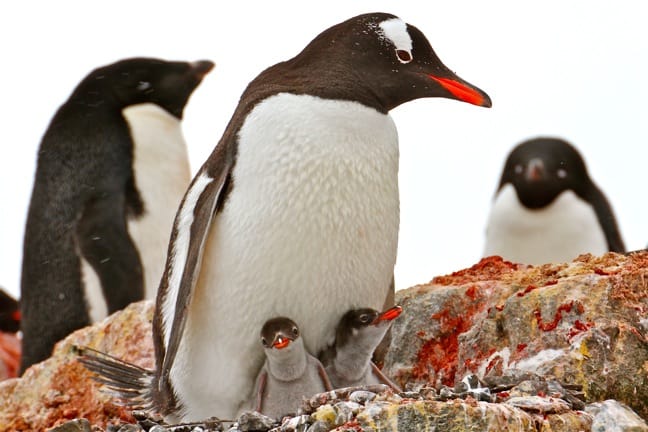 Mama Gentoo Penguin in Antartica with Two Baby Chicks
Mama Gentoo Penguin in Antartica with Two Baby Chicks
3. Antarctic Penguins
The charismatic penguins of Antarctica are always a highlight of any trip to the frozen continent. These funny, flightless birds are the most common animal you’ll see in Antarctica, with some colonies more densely populated than your average small city.
The Emperor Penguin, with its bright yellow plumage and impressively tall stature, is one of the most iconic symbols of the South Pole. But they tend spend most of their time inland, which is usually out of reach for most Antarctic cruises.
You will, however, see thousands of Chinstrap, Adelie, and Gentoo penguins. While these more diminutive species may not have the same star quality as the Emperor or King penguin, you may find their personalities more endearing.
Especially the little penguin chicks, which are often seen during the peak of Antarctica’s cruise season (December through February).
READ MORE: PHOTO GALLERY: Penguins of Antarctica
 Crabeater Seal Yawning on an Iceberg in Antarctica
Crabeater Seal Yawning on an Iceberg in Antarctica
4. Antarctic Seals
There are six different types of seals in Antarctica. While they tend to spend a lot of their time feeding underwater, you’ll have a great chance to spot many of them sunning themselves on rocky shorelines or resting on top of ice floes.
The largest and most spectacular species is the Elephant seal, and places like Elephant Island offer the chance to get up close and personal with the massive beasts.
Since they often weigh in excess of 8,000 pounds, they’re very slow moving, which makes for easy photo opportunities.
Also keep an eye out for the Crabeater Seal, the cute Weddell Seal, and the Antarctic fur seal. Keep your distance from the fiercest of the lot, the Leopard seal, which is known to prey on penguins.
READ MORE: 70 Cool & Weird Animals from Around the World (An Epic Guide)
 Eye-to-Eye with a Humpback Whale in Antarctica
Eye-to-Eye with a Humpback Whale in Antarctica
5. Antarctic Whales
Antarctica truly puts the rest of the world to shame when it comes to whale watching: You can spot 10 different species of whales here.
And when we say “spot,” we don’t mean merely catching glimpse of a tail off the in the distance through your binoculars. We mean drying off from the spray, because a Humpback whale has breached within a few hundred feet of your boat.
The reason you’ll find such a high concentration of whales in Antarctica?
The massive swarms of krill that live in these waters. Look out for the Minke whale, Blue whale, Sperm whale, Southern right whale, and Humpback whale, all of whom are motivated by the invitation of a buffet feast!
READ MORE: Seeing Whales That Live in Antarctica: A Dream Come True!
 Our First Sighting: Antarctic Killer Whales
Our First Sighting: Antarctic Killer Whales
6. Dolphins
If you’re a fan of cetaceans, you’ll be pleased to find an abundance of dolphins in Antarctica as well.
Dusky dolphins are the most commonly seen species, especially around Ushuaia, Argentina as you’re navigating the Beagle Channel at the start and/or end of your cruise.
You should also keep a keen eye out for the Orca. While commonly known as the killer whale, the orca is actually the world’s largest species of dolphin.
It has been estimated that more than 70,000 killer whales live in the oceans around Antarctica. If you’re lucky you might be lucky enough to catch sight of a hunt, which they often do in partnership as a pod.
READ MORE: 30 Cool & Weird Ocean Animals Around the World
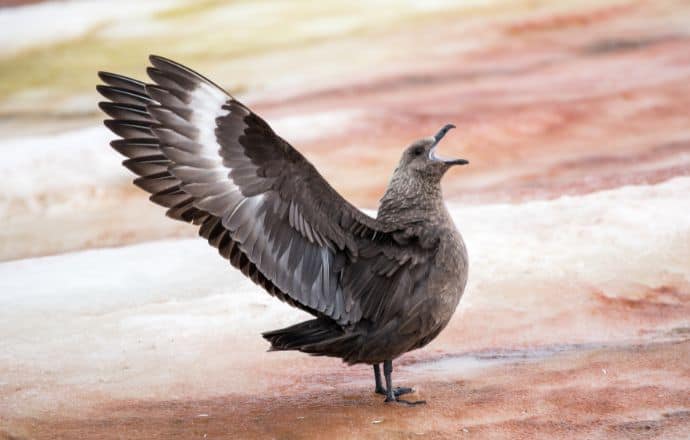 South Polar Skua via Canva
South Polar Skua via Canva
7. Birds of Antarctica
Antarctica is a fantastic destination for anyone with a love of birds (or at least a healthy fascination). The continent is home to over 100 million seabirds, which are also scattered throughout the sub-Antarctic islands.
You’ll find fascinating species such as the aforementioned penguins, fulmars, petrels, prions, and the Southern royal albatross.
While the albatross is an iconic species (its 9.5- to 11-foot wingspan is the largest of any bird on the planet), it’s the South Polar Skuas you should really watch out for.
The skua is a bulky brown seabird that often strategically chooses to nest around penguin colonies. This enables them to swoop in unexpectedly and feed on eggs and newborn chicks.
READ MORE: 5 Places Where Penguins Live (& Best Times to See Them There)
 On the Ground at King George Island’s Teniente R. Marsh Airport in Antarctica
On the Ground at King George Island’s Teniente R. Marsh Airport in Antarctica
8. The Antarctica Adventure
Antarctica is one of those rare, remote destinations where the process of getting there is a huge part of the adventure.
The Drake Passage is widely considered one of the most turbulent stretches of ocean you’ll ever cross.
However, tourism flights to Antarctica have recently been introduced. Because of unpredictable weather conditions plan on adding a few extra days to your itinerary to arrive and depart.
Once you get there, the adventure never ends. Next, we’ll take a look at the huge range of incredibly cool things to do in Antarctica.
READ MORE: How Do You Get To Antarctica Without Crossing The Drake Passage?
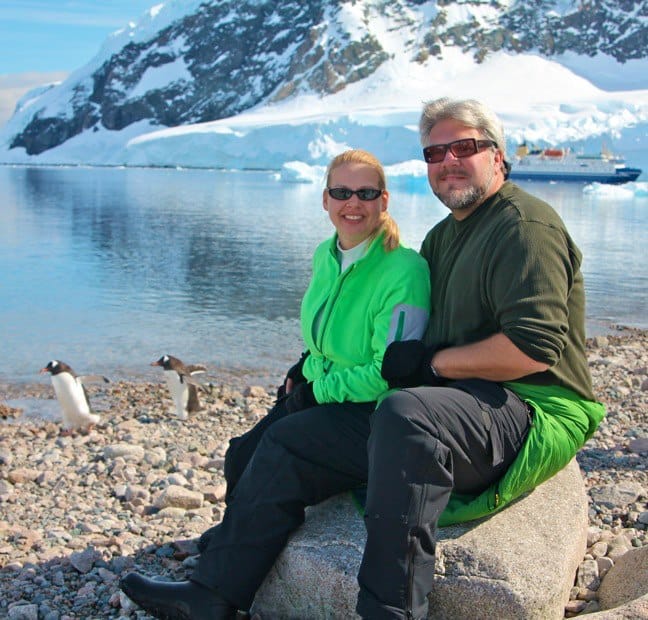 Hiking in Antarctica Bret Love & Mary Gabbett
Hiking in Antarctica Bret Love & Mary Gabbett
9. Antarctica Hiking
Most people who travel to Antarctica want to set foot on the continent, so hiking its icy landscape is a huge draw. It doesn’t matter how in shape you are: There are hiking opportunities for practically every fitness level, and most of them are non-technical.
Whether you’re taking a short walk across a volcanic beach rocky or hiking up a short hill to a glacial lookout, the scenery that surrounds you is so stunning that you won’t even notice the exercise.
After all, in what other destination on Earth will you have a chance to trek across an ice shelf to a beautiful bay filled with glistening icebergs, passing through the middle of a massive penguin colony along the way?
READ MORE: 50+ Pieces of Advice I Would Include in a Letter To My Younger Self
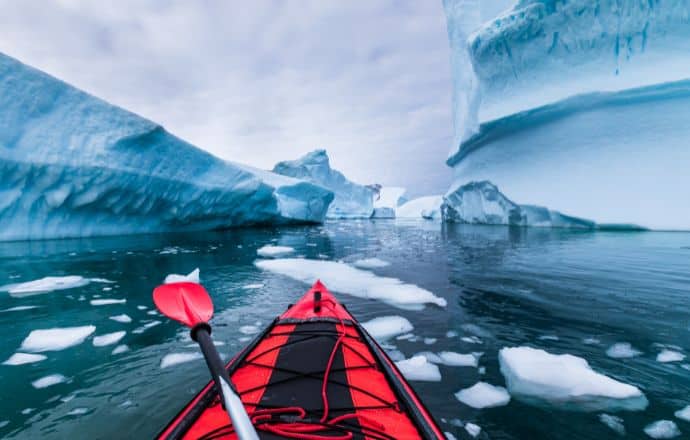 Kayaking in Antarctica via Canva
Kayaking in Antarctica via Canva
10. Antarctica Kayaking
If you’ve never kayaked in the open sea before, Antarctica is a magical place to do it for the first time. It’s also one of the best ways to immerse yourself in the exceptional scenery you see from the ship.
As you paddle through the area’s icy waters, you’ll get up close to towering icebergs and have a chance to explore inlets that are too small for the cruise ship to navigate.
You may find yourself face to face with penguins, whales, and/or seals, getting a rare chance to see them at eye level as they swim alongside you.
Kayaking is typically a limited activity that you may have to book as an extra. It’s well worth booking in advance if it’s something you really want to do, as this is a popular activity, and the spaces often fill up quickly.
READ MORE: 15 Harmful Traditions & Cultural Practices Tourists Should Never Support
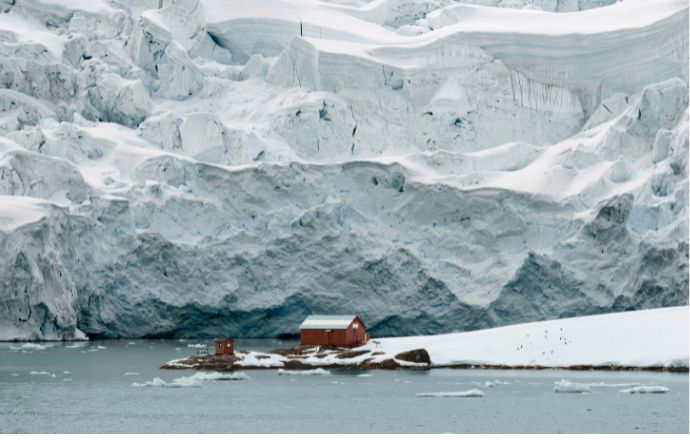 Almirante Brown Station, Argentine Antarctic Base & Scientific Research Station via Canva
Almirante Brown Station, Argentine Antarctic Base & Scientific Research Station via Canva
11. Visiting an Antarctica Scientific Research Base
Visiting a scientific research base is an unexpected highlight of most Antarctic cruise itineraries. Roughly 30 countries have scientific research bases set up across Antarctica.
The scientists based there are continuously studying the climate, wildlife, and geology of the region. And while some might resemble a run-down shack on a hillside, others are slick, modern villages the size of a small town.
Most cruises to Antarctica offer the chance to visit a couple of research bases, allowing you to walk around the facilities and chat to the staff who work on the base.
This is a great opportunity to gain insight into the realities of human life in Antarctica. It’s from here that you’ll be able to send postcards to friends and family, drink at an Antarctic bar, or add unique stamps to your passport.
These bases are considered the territory of the country that runs them, so you can easily visit Chile and Russia (and get those cool stamps) in the same day.
Because the political and economic priorities of these countries may shift over time, it’s a good idea to travel now for this experience, while Antarctic research still receives a good deal of funding!
READ MORE: 30 Amazing Galapagos Islands Animals
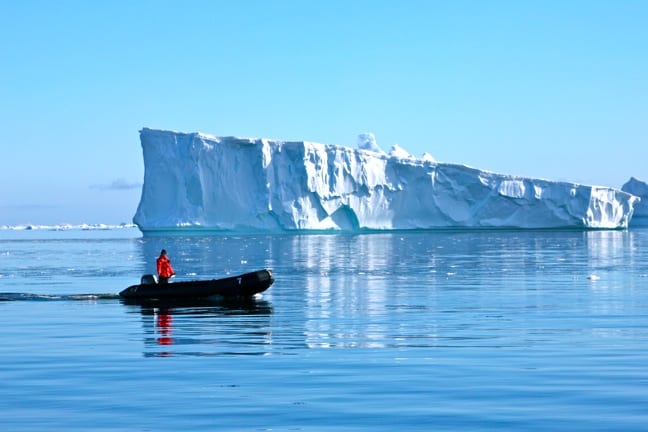 Zodiac Ride next to Icebergs in Antarctica
Zodiac Ride next to Icebergs in Antarctica
12. Antarctica Zodiac Rides
While Zodiacs are generally used as a practical way of transporting travelers from ship to shore, these small, motorized rubber boats also make for great cruising on their own.
Zodiac adventures allow travelers to access more remote islands, go ashore on beaches, and cruise through channels that are too small for a full-sized ship.
But unlike a kayak, a Zodiac has the power to take off quickly if you spot whales or other wildlife in the distance.
READ MORE: How To Avoid Products With Palm Oil (Including Your Favorite Brands)
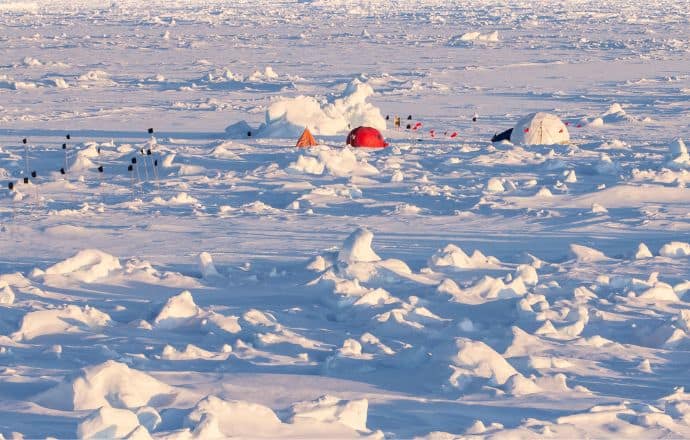 Camping in Antarctica via Canva
Camping in Antarctica via Canva
13. Camping on Antarctica Ice
While your cruise ship may have all the luxuries of home– a comfy bed, hot shower, entertainment, prepared foods– some adventurous travelers willingly trade all of that for a night out on the Antarctic ice.
Camping in Antarctica is an incredible way to immerse yourself in the landscape and experience the type of bare-bones accommodation that explorers like Ernest Shackleton endured.
Your camping gear will be provided, but that doesn’t mean you should expect to be issued a tent. Many Antarctic camping excursions require you to hike to the top of a glacier and dig yourself a hole!
Of course, you’ll be given a sleeping bag, a mat, and a waterproof bivvy bag, settling down as an ocean of stars emerge above.
It’s a once-in-a-lifetime experience to watch as the midnight sun sets and allow yourself to be engulfed by the continent’s vast silence. You may wake up to the sounds of ice calving off nearby glaciers, or penguins calling out for their mates.
READ MORE: What is Glamping? (A Introductory Guide to Luxury Camping)
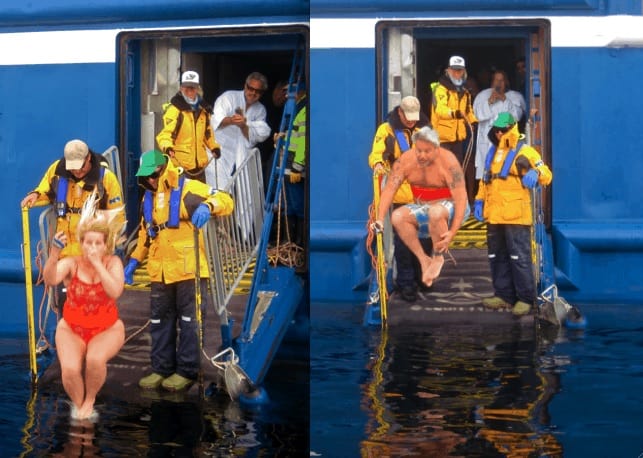 Bret Love & Mary Gabbett Taking the Polar Plunge in Antarctica
Bret Love & Mary Gabbett Taking the Polar Plunge in Antarctica
14. Taking the Polar Plunge in Antarctica
A swimsuit may not be the first thing you think to pack for Antarctica, but the Polar Plunge is a long-held tradition among adventurous travelers.
Jumping in for a brief dip into sub-freezing cold waters is considered a rite of passage for Antarctic explorers.
Depending on your Antarctic cruise itinerary, you may have the chance to jump from your ship or swim out from the shore of the beach at Deception Island.
When your warm skin hits those 29º Fahrenheit waters, the adrenaline rush actually prevents you from going into shock.
Thankfully, you won’t spend more than a few seconds in the water, and there’s often a shot of liquor on hand to warm you up as you get out.
READ MORE: Mary’s Hilarious Freakout During the Polar Plunge in Antarctica
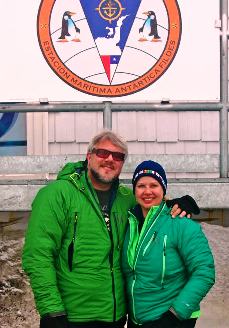 Antarctica Photo Spot
Antarctica Photo Spot
15. Unique Antarctica Photo Opportunities
In this era of Instagram, it’s increasingly rare to come home with unique vacation photos.
From the Grand Canyon and the Eiffel Tower to the Taj Mahal, many of the world’s most iconic destinations suffer from overtourism and the landmarks have been photographed to death.
But, for now, Antarctica remains a relatively off-the-beaten-path destination that few have had the privilege of visiting. Around 45,000 people travel to Antarctica each year, compared to the five million who visit the aforementioned attractions annually.
So you can take pride in photographing scenes most people have never seen before, such as ice calving from glacier or a kayaker moving through the water in the shadow of a humpback whale.
These days almost everyone throws their photos up on social media after a trip.
But the pictures you take in Antarctica are the type you’ll actually want to print or possibly even make a photo book from. They’re memories you’ll want to revisit for the rest of your life.
READ MORE: The 20 Best Festivals In The World (For Your World Travel Bucket List)
 Antarctica Cruise Ship with Crabeater Seal on an Iceberg
Antarctica Cruise Ship with Crabeater Seal on an Iceberg
16. Luxury Small Ship Cruises in Antarctica
Whether it’s high-rise apartments replacing family homes or a shrinking amount of leg space in economy, the trend these days seems to be about maximizing profits by cramming in as many bodies as possible.
Many destinations are now buckling under the strain of mass tourism, but thus far Antarctica has yet to fall prey to it. Still, with Antarctic tourism numbers tripling in the past 20 years, who knows how much longer that will be the case?
Small ship cruises– which are generally limited to less than 200 passengers– allow for a much more intimate and immersive experience. It also gives you the chance to enjoy true luxury, and it’s also better for the environment than massive cruise ships.
Life onboard today’s best Antarctic cruise ships is the opposite of the conditions the early explorers had to endure.
You’ll have access to luxury spas, fitness rooms, fine dining, fully stocked libraries, expert guest lecturers, and outdoor hot tubs that allow you to literally soak in the view.
READ MORE: 20 Best Caribbean Islands to Visit (If You Love Nature & Hate Crowds)
 Exploring the Icebergs Around Spert Island, Antarctica
Exploring the Icebergs Around Spert Island, Antarctica
17. Exploring a Relatively Untouched Frontier
Despite the increase in travelers to Antarctica over the last few decades, it’s by far the world’s least visited continent.
This is one of the biggest reasons to visit now: Antarctica is one of the rare places in the world that still feels largely untouched by man. When you go there, you feel like an intrepid explorer as opposed to a typical cruise ship passenger.
As you’re hiking across vast glaciers, with penguins hopping alongside you and icebergs dotting the horizon, it hits you that you’re doing things that go beyond the realms of typical travel.
It’s something that very few people in the world have ever had the chance to do, which makes the experience feel truly special.
READ MORE: 40 Interesting Facts About Snow Leopards
 Close-Up Views of Icebergs Near Spert Island, Antarctica
Close-Up Views of Icebergs Near Spert Island, Antarctica
18. Because the Climate is Changing
The effect of climate change in Antarctica is more obvious than in other parts of the world. This is not the same Antarctica that Shackleton and Mawson explored a century ago. And in as little as 5 to 10 years, science suggests it won’t be the same as it is today.
Temperatures in the Antarctic Peninsula have risen by 5º Fahrenheit since 1950. In fact, Antarctica is warming more rapidly than any other region on earth, making it one of the destinations most vulnerable to the effects of climate change.
The oceans surrounding Antarctica continue to rise as large ice shelves like the Larsen-C break off, and the continent’s largest glaciers continue to recede.
Warming oceans mean that Antarctic ice is melting at an alarming rate– five times faster than it should.
A large part of the continent is gradually disappearing, and in the future major ice breaks could cause huge issues for visiting cruise ships.
READ MORE: 10 Eco Lessons in Quotes from the Lorax (Dr Seuss’s Classic)
 Smooth Waters Made For Mirror-Like Reflections of Icebergs in Antarctica
Smooth Waters Made For Mirror-Like Reflections of Icebergs in Antarctica
19. The Price Mirrors the Temperature
As the temperature in Antarctica continues to rise, so does the cost of visiting. This is the result of rising fuel costs, as well as an increased demand for tourism to the region.
In order to preserve the pristine environment, Antarctic conservation laws limit the number of cruise ships and passengers allowed to sail through at any one time.
Since the season for available departures is already such a small window (late October through March), increased tourism demand makes availability more limited.
Some small ship cruises are already starting to fill up more than a year in advance, and these days most sail at full capacity. So with every year that passes, not only does the price increase, but it may become harder and harder to book a spot.
READ MORE:30 Facts About Tlingit Art, Culture & the History of Alaska’s Native Tribes
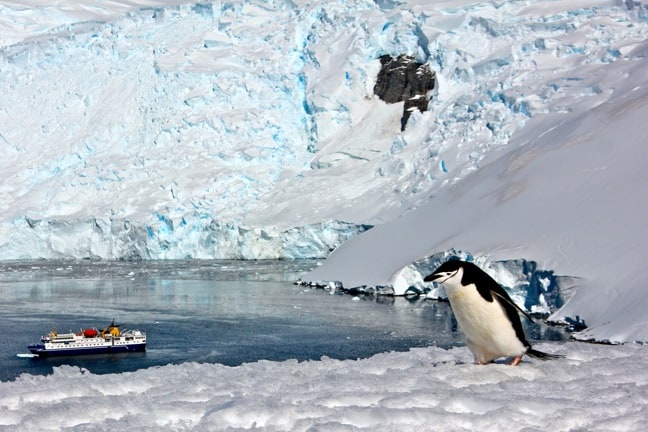 Chinstrap Penguin Above Orne Harbour with tourist ship in background
Chinstrap Penguin Above Orne Harbour with tourist ship in background
20. The Future of Antarctic Tourism is Uncertain
The governing bodies who regulate Antarctic tourism, such as the IAATO, have strict regulations in place in order to ensure that all tourism is undertaken responsibly, without any adverse effects to the local environment.
But some environmentalists have argued that the most responsible thing we can do for Antarctica is not to travel there at all.
While this faction is quite small, there is always the future possibility that, for the sake of conservation, visitor numbers may be further restricted or cut off entirely.
So, as the preservation of Antarctica has become a matter of global importance and international treaties like the Paris Agreement have been enacted to address global warming, the future of travel to Antarctica remains uncertain.
If you don’t visit Antarctica soon, it simply may not be an option when your “someday” finally comes. –by Megan Jerrard courtesy Green Travel Media, all photo by Bret Love & Mary Gabbett unless otherwise noted.
BIO: Megan Jerrard is an Australian Journalist and the founder and Senior Editor of Mapping Megan, an award-winning travel blog bringing you the latest in adventure travel from all over the globe.
The post 20 Reasons to Travel to Antarctica Now (Before It Changes) appeared first on Green Global Travel.
















